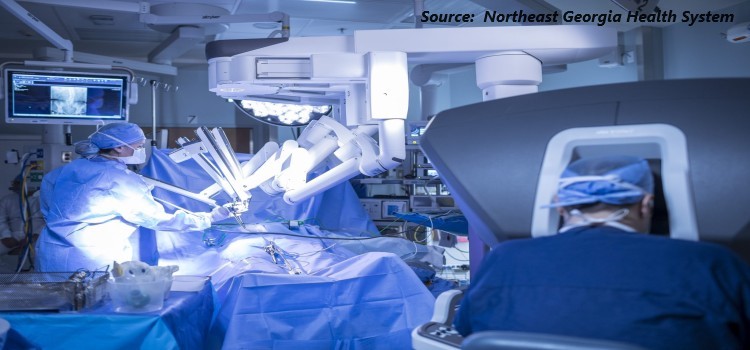
Surgical Instrument Market by Product (Surgical Sutures & Staplers, Handheld Surgical Equipment, and Electrosurgical Devices), by Application (Neurosurgery, Plastic & Reconstructive Surgery, Cardiovascular Surgery, Urology Surgery, Orthopaedic Surgery, Gynecological Surgery, Ophthalmic Surgery, Laparoscopic Surgery, and Others), by End User (Hospitals, Ambulatory Surgical Centers, and Clinics) – Global Opportunity Analysis and Industry Forecast, 2023–2030
Industry: Healthcare | Publish Date: 21-Jul-2023 | No of Pages: 401 | No. of Tables: 288 | No. of Figures: 250 | Format: PDF | Report Code : N/A
Market Definition
The global Surgical Instrument Market size was valued at USD 13.40 billion in 2022 and is predicted to reach USD 25.52 billion by 2030, with a CAGR of 7.9% from 2023 to 2030. A surgical instrument is a tool or device that is used by healthcare professionals during surgical procedures to perform various functions such as cutting, dissecting, grasping, clamping, holding, retracting, and suturing. These instruments are specifically designed to facilitate surgical procedures with precision, accuracy, and safety. Medical instruments come in various shapes and sizes.
The industry is highly competitive, with many companies producing a wide range of surgical instruments for various surgical specialties, including orthopedics, cardiology, neurology, and general surgery. The industry is also characterized by constant innovation, with companies developing new and improved instruments to meet the evolving needs of healthcare professionals.
Moreover, the industry is highly regulated, with strict quality control standards and regulations in place to ensure the safety and effectiveness of surgical instruments. Manufacturers must adhere to strict guidelines for design, materials, and manufacturing processes, and products must be rigorously tested and certified before they can be marketed and sold.
In addition, the industry is also characterized by significant consolidation, with larger companies acquiring smaller players to expand their product portfolios and market reach. The industry is expected to continue to grow, driven by the aging population, the increasing prevalence of chronic diseases, and the growing demand for minimally invasive surgical procedures.
The Increasing Number of Surgeries Worldwide
Surgical care has been an essential element of healthcare across the world. As the incidences of traumatic injuries, cancers, and cardiovascular diseases are continuously rising, the impact of surgical intervention on public health systems is also increasing rapidly across the globe. According to the World Health Organization (WHO), millions undergo surgical treatment and interventions every year. This is accounted for an estimated 13% of the world’s total disability-adjusted life years (DALYs).
The surgical instrument industry is growing due to advances in surgical technology including electrosurgical instruments, such as pencils, electrodes, and laparoscopic instruments. The development of more specialized instruments designed to perform specific tasks with greater precision and accuracy in complex surgeries.
Additionally, the expansion of healthcare infrastructure in emerging markets and the increasing adoption of minimally invasive surgeries are driving demand for surgical instruments, with a particular focus on minimally invasive surgical instruments designed for procedures through small incisions. These factors are expected to continue driving growth in the surgical instrument industry in the future.
Rapid Prevalence of Chronic Diseases
The increase in the frequency of chronic illnesses such as diabetes, asthma, cancer, stroke, heart attacks, and chronic obstructive pulmonary disease in low- and middle-income countries is leading to untimely deaths. However, some of these diseases could be treated with minimally invasive surgeries (MIS), which help to manage blood loss during surgical procedures.
According to the World Health Organization (WHO) in 2021, various types of chronic diseases such as cardiovascular diseases, cancer, respiratory diseases, and diabetes are responsible for approximately 17.9 million, 9.3 million, 4.1 million, and 1.5 million deaths, respectively. Moreover, 41 million people die each year, owing to chronic diseases. This is equivalent to 71% of the total deaths globally.
Additionally, the increasing need for laparoscopic surgeries, which involve the use of minimally invasive techniques to remove a damaged organ or collect tissue samples for biopsy, is expected to contribute significantly to the growth of the surgical equipment market. Besides, the growth of the surgical instrument industry has also been driven by the rising demand for diagnostic procedures like endoscopy.
Rise in the Use of Powered and Electrosurgical Instruments
The segment of powered and electrosurgical devices is projected to dominate the market in terms of product, driven by significant factors such as an increase in product launches, advancements in technology, and the growing use of electrosurgical devices in surgical procedures. These devices are employed to cut through and remove tissue, desiccate or destroy tissue, and control bleeding by coagulating blood. Electrosurgical devices are primarily utilized in cholecystectomy procedures. Additionally, many countries are witnessing a surge in surgical procedures due to the escalating burden of non-communicable diseases and injuries.
According to the Organization for Economic Co-operation and Development (OECD), laparoscopic cholecystectomy procedures and courses numbered 54,836 and 30,031, respectively, in Denmark and Costa Rica.
Several companies have implemented strategic initiatives to contribute to the growth of this segment. For instance, in June 2021, Ethicon (a subsidiary of Johnson & Johnson) introduced the ENSEAL X1 Curved Jaw Tissue Sealer, an advanced bipolar energy device that enhances procedural efficiency, offers more robust sealing, and enables access to more tissue than LigaSure Maryland. This device is utilized in colorectal, gynecological, bariatric, and thoracic procedures.
Stringent Regulations by the Regulatory Bodies
The industry is heavily regulated, and obtaining regulatory approval for new products can be a lengthy and costly process. This can slow down the pace of innovation and product development. Stringent regulations can restrain the surgical instrument industry by increasing the time and cost of development, delaying approval processes, limiting market access, increasing liability risks, and creating barriers to entry for new companies. Compliance with regulations is crucial, and failure to do so can result in lawsuits and product recalls, which increases costs and reduces investor support.
Growing Emphasis on Minimally Invasive Surgeries
Minimally invasive surgeries require instruments that can access small incisions and navigate the body's anatomy without causing excessive tissue damage. This has led to a surge in demand for specialized surgical instruments, such as laparoscopic instruments, endoscopes, and robotic surgical instruments.
Moreover, minimally invasive surgeries require a high level of precision and control, which has led to the development of new surgical instruments and tools that can provide surgeons with greater accuracy and visualization during procedures. This has created opportunities for manufacturers to innovate and develop new products that can meet these requirements.
Additionally, patients are becoming more aware of the benefits of minimally invasive surgeries, leading to increased demand for these types of procedures. This trend is likely to continue as patients seek out less invasive treatment options, providing new opportunities for surgical instrument manufacturers to develop new products that can meet this demand.
Asia Pacific is Projected to Dominate the Surgical Instrument Market
The region accounts for 60% of the world's population, leading to a significant number of surgeries coupled with the presence of giant economies including, Japan, China, South Korea, and India that contribute to the major share of the surgical instrument industry. As these countries have strong domestic markets and are significant exporters.
Moreover, the rising aging population in Japan and South Korea undergo surgeries more frequently creating more opportunities for the surgical instrument industry. According to the Ministry of Internal Affairs and Communications data in 2022, Japan holds the position of having the highest proportion of elderly citizens in the world with approximately 36.27 million people over the age of 65, accounting for 29.1% of the population.
In addition, the presence of prominent companies engaged in the manufacturing of surgical instruments, including Olympus Corporation, Terumo, Hoya, and many more. These companies have brought advanced technology, innovative products, and a wealth of expertise to the region with their R&D activities and collaboration strategies. Which in turn thrives the surgical instrument market growth.
North America to Witness a Substantial Growth
The growing cases of cataract removal, c-sections, joint replacement, and other surgeries among the population propels the growth of the surgical instrument market. As per the Vital Statistics Surveillance Report, primary cesarean delivery rates accounted for approximately 22.4% of all deliveries in the United States in 2021, amounting to 690,537 deliveries.
Moreover, the rising popularity of minimally invasive surgery in this region is driving market growth. This is due to the benefits of minimally invasive surgery over traditional surgery, such as smaller incisions, less pain, and a faster recovery time. Minimally invasive surgery is performed with specialized instruments and endoscopes that are inserted through small incisions to access the surgical site.
In addition, the North American surgical instrument market is benefiting from the growing popularity of outpatient surgery. This trend is helping to reduce healthcare costs by allowing patients to recover at home after surgery, rather than staying in the hospital. This is creating new opportunities for surgical instrument manufacturers to develop and market specialized instruments and equipment that are needed for outpatient surgeries.
Furthermore, The United States is home to many of the world's leading surgical instrument manufacturers including, Stryker Corporation, Boston Scientific, and Intuitive Surgical. These companies invest heavily in research and development, which helps to drive innovation in the industry. This innovation, in turn, helps to foster market growth.
Competitive Landscape
Various market players operating in the surgical instrument market report include B.Braun, Smith & Nephew, Zimmer Biomet, Stryker Corporation, Medtronic, Ethicon, Conmed Corporation, Intuitive Surgical, Olympus Corporation, Boston Scientific, and many more. These market players are adopting strategies such as product launches across various regions to maintain their dominance in the surgical instrument industry.
For instance, in March 2023, Smith & Nephew launches Visionaire, a 3D printing platform for patient-specific orthopedic instruments. The platform is designed to help surgeons perform procedures with greater precision and accuracy, leading to improved patient outcomes. Visionaire is currently being used in a variety of orthopedic procedures, and Smith & Nephew plans to expand its use in the future.
Moreover, in June 2022, Ethicon (J&J) launched the ECHELON 3000 Stapler, a digitally enabled device that provides surgeons with one-handed powered articulation to address unique patient needs. The first-of-its-kind stapler allows surgeons to access and close difficult-to-reach areas, such as the pelvis and sacrum, with ease. It also features a new, intuitive user interface.
Furthermore, in September 2022, Olympus launched THUNDERBEAT Open Fine Jaw Type X surgical energy devices to perform safer procedures. This surgical instrument is equipped with two types of energy ultrasonic and bipolar. Ultrasonic energy is used to cut tissue, while bipolar energy is used to seal blood vessels and prevent bleeding. This combination of energy allows THUNDERBEAT hybrid devices to perform a variety of tasks, including cutting tissue, sealing blood vessels, dissecting tissue, and coagulating tissue.
In addition, in June 2021, Intuitive Surgical launched the SureForm Robotic-Assisted Surgical Stapler, a device that uses robotic technology to help surgeons perform more precise tissue resections. It is designed for use in various surgical procedures and can deliver a range of stapler cartridges. The SureForm can reduce the risk of complications and improve cosmetic outcomes. It is available in the U.S. and Europe, with plans to expand to other countries.
Surgical Instrument Market Key Segments
By Product
-
Surgical Sutures and Staplers
-
Sutures
-
Staplers
-
-
Handheld Surgical Equipment
-
Forceps
-
Retractors
-
Graspers
-
Suction Device
-
Cutting Instruments
-
Scalpels
-
Scissors
-
Blades
-
-
Auxiliary Instruments
-
Clamps
-
Cannulas
-
Wound Closure Strips
-
-
Others
-
- Electrosurgical Devices
By Application
-
Neurosurgery
-
Plastic and Reconstructive Surgeries
-
Cariovascular Surgery
-
Urology Surgery
-
Orthopaedic Surgery
-
Gynecological Surgeries
-
Ophthalmic Surgeries
-
Laparoscopic surgeries
-
Others
By End User
-
Hospitals
-
Ambulatory Surgical Centers
-
Clinics
By Geography
-
North America
-
U.S.
-
Canada
-
Mexico
-
-
Europe
-
UK
-
Germany
-
France
-
Italy
-
Spain
-
Denmark
-
Netherlands
-
Finland
-
Sweden
-
Norway
-
Russia
-
Rest of Europe
-
-
Asia-Pacific
-
Australia
-
China
-
India
-
Indonesia
-
Japan
-
Singapore
-
South Korea
-
Malaysia
-
Thailand
-
Rest of Asia Pacific
-
- RoW
-
Latin America
-
Middle East
-
Africa
-
Report Scope and Segmentation
|
Parameters |
Details |
|
Market Size in 2022 |
USD 13.40 Billion |
|
Revenue Forecast in 2030 |
USD 25.52 Billion |
|
Growth Rate |
CAGR of 7.9% from 2023 to 2030 |
|
Analysis Period |
2022–2030 |
|
Base Year Considered |
2022 |
|
Forecast Period |
2023–2030 |
|
Market Size Estimation |
Billion (USD) |
|
Growth Factors |
Increasing number of surgeries worldwide Rapid prevalence of chronic diseases |
|
Countries Covered |
28 |
|
Companies Profiled |
15 |
|
Market Share |
Available for 10 companies |
|
Customization Scope |
Free customization (equivalent to up to 80 working hours of analysts) after purchase. Addition or alteration to country, regional, and segment scope. |
|
Pricing and Purchase Options |
Avail customized purchase options to meet your exact research needs. |
KEY PLAYERS
-
B.Braun
-
Smith & Nephew
-
Zimmer Biomet
-
Stryker Corporation
-
Medtronic
-
Ethicon
-
Conmed Corporation
-
Intuitive Surgical
-
Olympus Corporation
-
Boston Scientific




 Speak to Our Analyst
Speak to Our Analyst


































